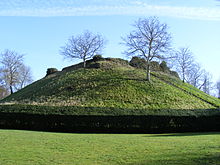Waytemore Castle
Waytemore Castle is a ruined castle in the town of Bishop's Stortford in the English county of Hertfordshire . English Heritage has listed the remains of the castle as Grade I Historic Buildings.
In the reign of King Wilhelm I , a moth was first erected. In the 12th century a donjon with a rectangular plan was added on the mound . This was reinforced in the 13th century, during the reign of Johann Ohneland , and in the middle of the 14th century there was a royal permit to fortify the structure (English: License to Crenellate).
After the English Civil War , the castle was razed . In the 17th century it served as a prison.
Today only the earthworks , the large mound and the foundations of the rectangular donjon are preserved.
history
Some historians believe that the history of the Mound began as a Celtic barrow , while others believe the hill to be an Anglo-Saxon Buhr , a moat and palanke fortress built by Edward the Elder as a defense against the advancing Danes .
It used to be thought that the name Waytemore Castle was composed of the Anglo-Saxon words "wayte" (English: ambush) and "more" (English: swamp, marshland). The historian Jacqueline Cooper thinks, however, that the part of the name “wayte” represents a corruption of “thwaite”, a word that comes from Old Norse and means “clearing of the forest” in German. The word “marr” also comes from Old Norse and means “swampy place” in German. If so, the name suggests that the Norman castle was built on previously used land that has been cleared of damp, sparse forest.
moth
Whether the wooden moth was from Norman or Anglo-Saxon times, the conversion into a stone castle will probably have taken place after 1086, although one also thinks that the donjon was not built before 1135. The mound of earth became the foundation for the well-known moth and the location in a valley and not on an elevated location, as with other systems of this type, was intentionally chosen to protect an important ford in the river.
The 12.8 meter high mound was surrounded with a ditch and its summit was protected by a curtain wall made of flint and quarry stone, 2.7 meters thick. The later built donjon, probably 18-21 meters high, stood inside this curtain wall and its walls were painted white with a mixture of lime and chalk to make it visible from afar and the Anglo-Saxon residents of the city and the surrounding area to Norman power and to remember the conquest of the land. The discovery of the flint and quarry stone foundations suggests that the donjon was rectangular in shape. However, only three sides of the rectangle were straight, the north side was convex and sometimes irregularly shaped and consisted of Roman bricks and medieval tiles.
ruins
The remnants of the walls on the summit of the Mound are those of the donjon, which was renewed in 1214 at the behest of King John Ohneland. The original fountain in the south-west corner of the courtyard is covered by a large steel plate.
The mound was never properly excavated, although an investigation in 1850 revealed part of the existing walls and some human bones. A local historian, JL Glasscock , made further small attempts at scientific excavations in 1900, but found only a few Roman coins from the Byzantine Empire . The most informative find on the site was made accidentally in the 1990s; a large number of human bones were found, which, according to experts, indicate that a kind of medieval hospital was attached to the castle.
Individual evidence
- ↑ Remains of Waytemore Castle . Historic England. English Heritage. Retrieved November 25, 2016.
swell
- Plantagenet Somerset Fry: The David & Charles Book of Castles . David & Charles, Newton Abbott 1980. ISBN 0-7153-7976-3 .
- Waytemore Castle . Bishop's Stortford Town Council.
Web links
Coordinates: 51 ° 52 ′ 19 ″ N , 0 ° 9 ′ 46.7 ″ E
